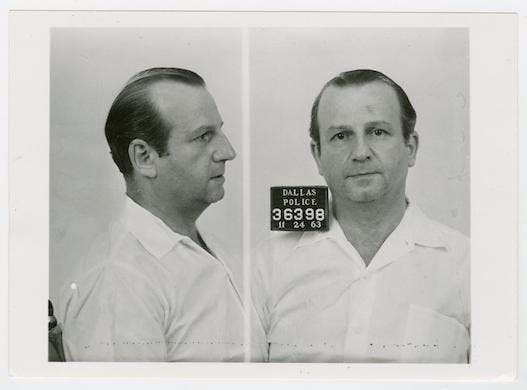The Real Jack Ruby
The biographer, in my estimation, writes a narrative of Ruby’s life that is in itself a refutation of the conspiratorial contentions that he was acting on behalf of other parties in assassinating Lee Harvey Oswald.

‘Jack Ruby: The Many Faces of Oswald’s Assassin’
By Danny Fingeroth
Chicago Review Press, 352 pages
Conspiracy theories pullulate and many seem believable, and that’s the trouble: With so many that are credible to consider, it’s just incredible. Was Jack Ruby part of a scheme to get Lee Harvey Oswald out of the way, did Ruby know Oswald, and was it the mafia — no, wait, the CIA/FBI, Cuba, and the Kremlin were behind all of it? What is the “it,” anyway?
The conspiracy lore threatens to obliterate who Ruby was, and that is perhaps why Mr. Fingeroth makes no effort to analyze the suspicions about the Kennedy assassination or Ruby’s part in it in order to provide his own theory of the case.
Mr. Fingeroth meticulously sorts through everything that tells him anything about the man: where he came from, what he believed, his attitude toward the Kennedys, his interactions with both the police and crime figures.
Many of the principals in the story of Jack Ruby are dead, but Mr. Fingeroth began work on his biography a decade ago, interviewing those who knew Ruby’s family, and, most importantly, talking with Ruby’s rabbi, who was there in Dallas during Ruby’s imprisonment and trial. The biographer, in my estimation, writes a narrative of Ruby’s life that is in itself a refutation of the contentions that he was acting on behalf of other parties.
Ruby, to put it charitably, was an erratic man. Some would even say, in the vernacular, that he was crazy. He had a volatile temper and was prone to getting into fights and throwing his adversaries down the steps in the Dallas clubs he owned.
Ruby worshiped the Kennedys and identified with Catholics as a persecuted minority like his fellow Jews. He gave several explanations of why he killed Oswald, but the one that always seemed to stick is that he believed he could, in one shot, spare Jacqueline Kennedy from appearing in Dallas at Oswald’s trial while also declaring Jewish solidarity with the Catholic Kennedys.
For all his violence, though, Ruby could be a regular guy, a caring man, a lover of dogs (dachshunds), and a benefactor of employees who got into trouble. His family, by and large, stood by him, and considered his murder of Oswald an aberration.
What kind of aberration? One of Oswald’s attorneys, Melvin Belli, had a theory that he thought explained Ruby’s actions, a theory that overruled the assassin’s contradictory claims. Belli called a psychiatrist, Roy Schafer, to the stand at Ruby’s trial to testify that Ruby suffered from “psychomotor epilepsy.” If “emotionally distraught,” a person with such a brain disorder could become “subject to uncontrollable and explosive behavior.”
Another psychiatrist, Walter Bromberg, said Ruby had been in a “fugue” state when he shot Oswald. With Ruby’s consciousness impaired, he acted “without conscious thought.”
Some of Ruby’s own comments on his behavior corroborate what the medical experts said, though other specialists would not go so far as to say Ruby had acted without premeditation, or that in the act of murdering Oswald, Ruby no longer could tell the difference between right and wrong. Rabbi Silverman, who became quite close to Ruby, thought of him as “emotionally unstable.”
A court overturned Ruby’s conviction and death sentence, but he died in 1967 before he could be retried. Until his death, he worried that his actions would lead to another Holocaust for the Jewish people. He volunteered to take a polygraph. The scene with the Warren Commission, during which Ruby was able to take Earl Warren aside and plead his case, is one of the most fascinating parts of the book.
So is Mr. Fingeroth’s final chapter, “Afterlilfe,” which reads like a Victorian novel in which we learn about the fate of the characters so many years after Ruby’s death — what happened to his family, the investigations and first conspiracy books, and government documents that are still being released, the last batch in December 2022, with more yet to come.
“The idea of Jack Ruby embodying and symbolizing a regular guy who forced his way into history is a powerful one,” Mr. Fingeroth concludes: “Maybe that’s his legacy, a perverse twist on the idea that ‘one person can make a difference.’”
Mr. Rollyson’s treatment of conspiracy theories can be found in his revised and updated edition of “Marilyn Monroe: A Life of the Actress.”

